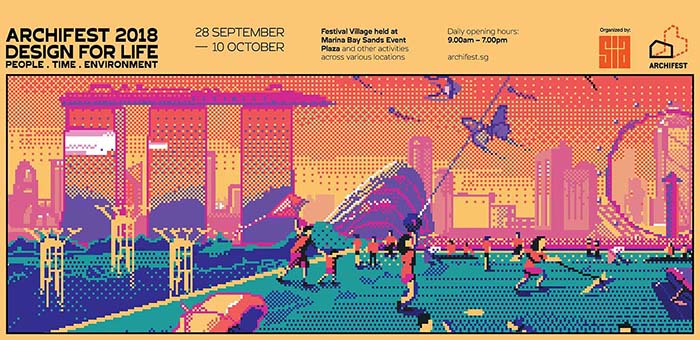
Archifest 2018
Archifest is an annual public architecture festival organised by the Singapore Institute of Architects, to celebrate the architecture and built environment.
It is a platform to engage and bridge the public and various professions with the evolving role of Architects, to take action in our own capacities to make a positive impact for the good of humanity. Through our projects, multi-disciplinary collaborations, conferences, workshops and teaching, we hope to show that Design, when harnessed in the right way, has great potential to reflect the richness of human values, our history and development, and enhance the world we live in for our future generations.
Theme
Design for Life is a theme which broadly encompasses the Architect’s vision to respond to the true needs of humanity. In a society where “more is more” and “new is better”, the world’s outlook does not look too favourable. There is a need for design to give back to the community and enrich human life as a whole. The main theme is elaborated in 3 sub-themes: Design for People, Design for Time and Design for Environment.
Design for People promotes better life & well-being. Much of the spotlight of Architecture has been shone on the award-winning mega-projects designed by famous architects, while the day-to-day architecture sits in its shadows. The irony of this is that although these projects are thought to be making the most impact in the design world, a large proportion of the population in Southeast Asia falls outside the reach of these iconic, spectacular buildings. Designing for the 99% may not be the most glamorous, but it certainly is a celebration of the non-spectacular. Domestic architecture, social housing, elderly care and humanitarian architecture are examples of projects which are often overlooked but are the backbone of an effective society. Close engagement with the community in the design-stage also has the potential for far-reaching effects. This bottom-up approach to designing opens up the dialogue to create spaces which promote people’s health, happiness and well-being. Not only are designers more in touch with the needs of the community, but community participation plays a part in the desacralization of the profession of Architecture.
Design for Time addresses the lifespan of building design. Few Architects design buildings thinking that it will soon be demolished. However, the reality of construction in Singapore is that there is a continual contest on whether the old should make way for the new, in the name of progress. Not only is this practice a strain on natural resources, but a part of history is inevitably lost in the rubble. The preservation of Modern architecture is likened to having a time capsule of the past, however, it is not as simple as burying a box in the ground. There has to be a conscious effort made to maintain buildings in their current state, to prevent further damage and slow down the process of deterioration. Designing for the long-haul also requires a new kind of Architecture which is in constant evolution over time, and is not just static until it is demolished. Projects can be developed in phases, or buildings readapted as its usage changes. Buildings ought to be living organisms which adapt to their surroundings, continually making an impact on the users which come and go.
Design for Environment enhances the life of our planet, flora and fauna. Society is accountable to live responsibly for the good of future generations by reducing energy consumption and waste. The excessive use of plastic in Singapore and the rest of the world has taken a tow on the ecosystem. Global warming is no longer a myth but a stark reality for many communities who have to deal with the grave consequences of natural disasters and sickness. Architects now have the responsibility to conceive and initiate ways to promote truly sustainable practices, be it in the form of using recyclable materials or designing low carbon footprint buildings. The materials used in buildings themselves can be extracted and reclaimed, rather than adding to the hefty demand for depleting resources. Hence sustainability is not merely switching out something for something else, but it is devising smart solutions to reduce our strain on the environment and to use materials prudently. As we continue to pride ourselves as a regional hub, Singapore’s geo-strategic location should allow us to see beyond economic benefits to create a better living environment for all.
